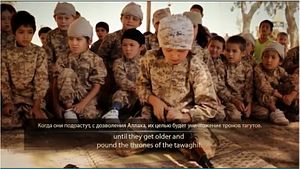Earlier this week, the forces behind the ISIS video production team released one of their most excruciating offerings yet. The video opens with a pair of testimonies – two men, strained and twitching, claiming their work within Russia’s Federal Security Service (FSB), admitting their espionage within ISIS’s ranks. One man, Zhanbolat Mamaev, claims to be from Kazakhstan. The second says his name is Sergei Ashimov, a thirty-year-old former Muslim. Both claim to be searching for tactical information on ISIS – where the group’s leadership is located, information about the Russians in ISIS’s ranks. At some point, their work was found out. The duress in their confessions spills through the screen.
The video then transitions outside, with Mamaev and Ashimov kneeling in the scrub and sunlight. An ISIS fighter stands behind, invoking Quranic verse and ISIS pledge – rote, expected language. Aside this fighter, though, is a child, watching. A young boy, no more than 12 years old. He appears to be the same Kazakh child from an earlier ISIS video, a lead interview who had described how, with the rest of the Kazakh schoolchildren under ISIS’s watch, “We’re going to kill you, O kuffar. Insha’allah, we’ll slaughter you.” This time around, looking emotionless, the child holds a pistol. The incantations finish. The boy raises the gun, and fires, and the two men crumple in front of him. The child keeps firing. The video fades to black.
Before delving into the fallout from the video, which has already been taken down, a few caveats. There’s no way of confirming whether these two men were at all who they claimed to be. Kommersant has cast heavy doubt on their claims of being FSB agents, reporting that Ashimov, also from Kazakhstan, had recently finished his work as a janitor and perfume-seller in Kazan, Russia. The paper also noted that the absence of “heavy bleeding,” in conjunction with the lack of last-ditch pleas, called into question the execution itself. Global Voices ran through further concerns about the video’s authenticity, sharing questions of “tricky camera angles” and a lack of recoil. As it is, the FSB has remained mum on the identities of the two men. Kazakhstan’s National Security Committee has further said the two were not Kazakhstani citizens.
Nonetheless, even if the video was an elaborate, gruesome hoax, fallout remains. Kazakhstan didn’t take long to issue veiled threats to any media outlets that would think to report on the video, and local outlets have so far avoided reporting on the Kazakhstani identities of the victims. This clampdown on media freedoms follows Kazakhstan’s threats resulting from last fall’s video – which saw Astana eventually pressure Bishkek into blocking Kloop, an independent Kyrgyzstani media outlet reporting on ISIS’s initial video. (Bishkek’s decision to block Kloop was one of the starkest examples of Kyrgyzstan’s rights backslide in 2014.)
Regardless of how widely the video will be viewed in Central Asia, the clip presents ISIS’s attempt at a significant escalation in their rhetorical targeting of both Russia and Central Asia. The fact that ISIS saw fit to utilize a Kazakh child in (apparently) executing a pair of individuals from Kazakhstan – especially another ethnic Kazakh – is a move pointed squarely at Astana. The Kazakhstani government claims that it’s managed to identify the country’s citizens – some 300, at the last official estimate – who have uprooted to fight with ISIS. Maybe it has. But these individuals, these children, are still there. And ISIS is seemingly turning them against others from Kazakhstan. Pressure on Astana from frightened citizens and nervous officials will increase that much more. Pressures on the local populations, stemming from governments looking for any way to stem the flow to Iraq and Syria, will rise commensurately. Russia and the rest of Central Asia will follow suit.
One of the ironies within this response is that the video doesn’t really tell us anything new. The child in question was already featured as ISIS’s focal interview a few months ago; there’s no indication in the new video that Central Asian numbers within ISIS’s ranks have grown since. Indeed, just as with prior beheadings, the video may yet serve to slow potential recruitment among Central Asian ranks. Whatever anti-state appeal ISIS may hold, there’s little stomach for, or familiarity with, such extreme brutality among vast swaths of Central Asia. The video may well be one of the more self-defeating exercises ISIS has yet tried.
That remains to be seen. In the interim, though, the governments have been handed further fodder to increase means of surveillance and pressure on any individuals or groups suspected of connection to ISIS – or even those who aren’t. This, in turn, only heightens the appeal of Islamist groups the governments are claiming to staunch. The cycle continues. And a Kazakh child continues living within ISIS’s territory, living evermore with the knowledge that he likely executed a pair of those who’d hailed from the same home he once knew.
































